Case Study: Appendicitis
VerifiedAdded on 2020/12/29
|8
|1991
|162
Essay
AI Summary
This essay analyzes a case study of a child with appendicitis, examining the pathophysiology, applying growth and development theories, and discussing the impact of hospitalization on the child and family, highlighting the importance of family-centered care.
Contribute Materials
Your contribution can guide someone’s learning journey. Share your
documents today.
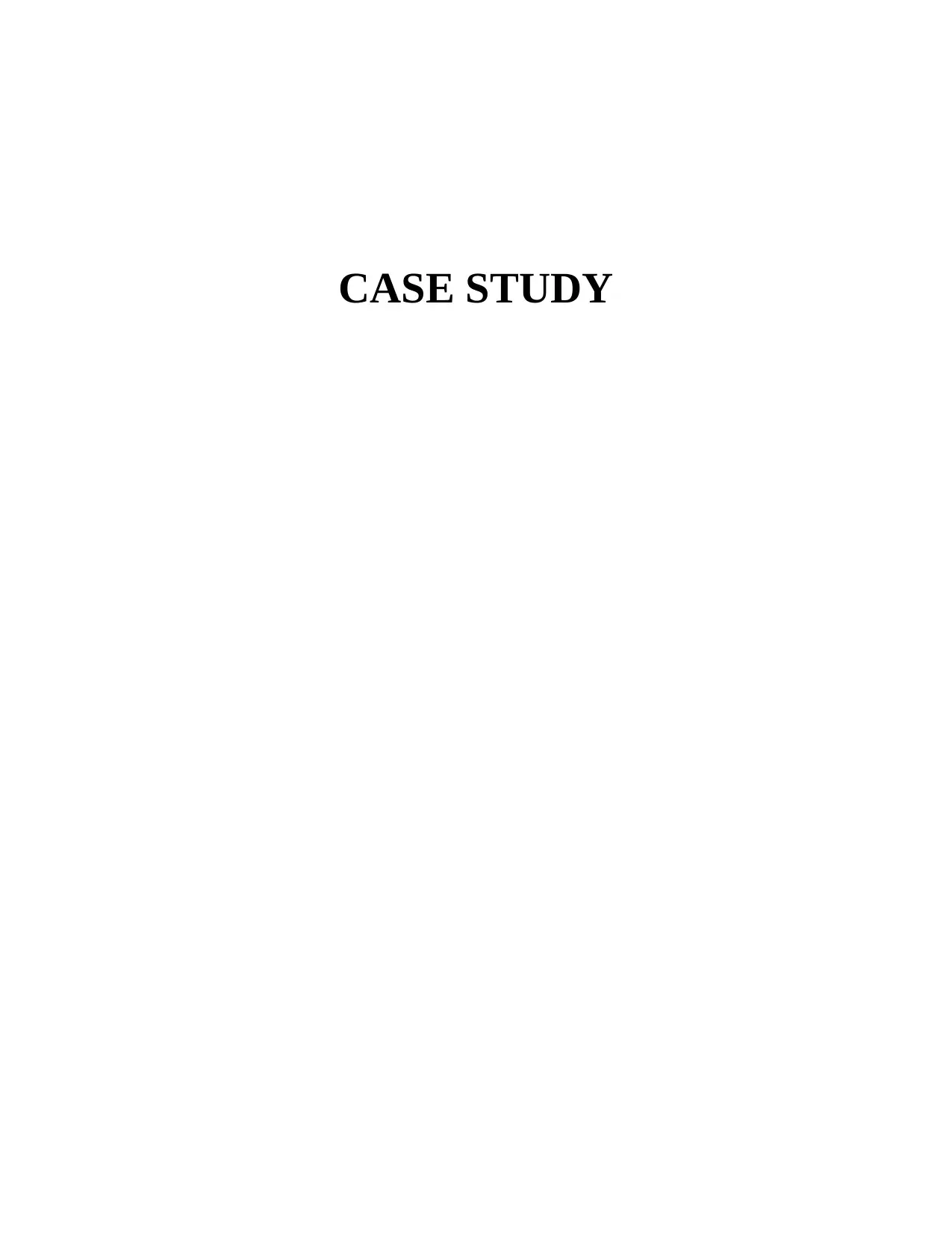
CASE STUDY
Secure Best Marks with AI Grader
Need help grading? Try our AI Grader for instant feedback on your assignments.

TABLE OF CONTENTS
INTRODUCTION...........................................................................................................................1
MAIN BODY...................................................................................................................................1
CONCLUSION................................................................................................................................4
REFERENCES................................................................................................................................5
INTRODUCTION...........................................................................................................................1
MAIN BODY...................................................................................................................................1
CONCLUSION................................................................................................................................4
REFERENCES................................................................................................................................5
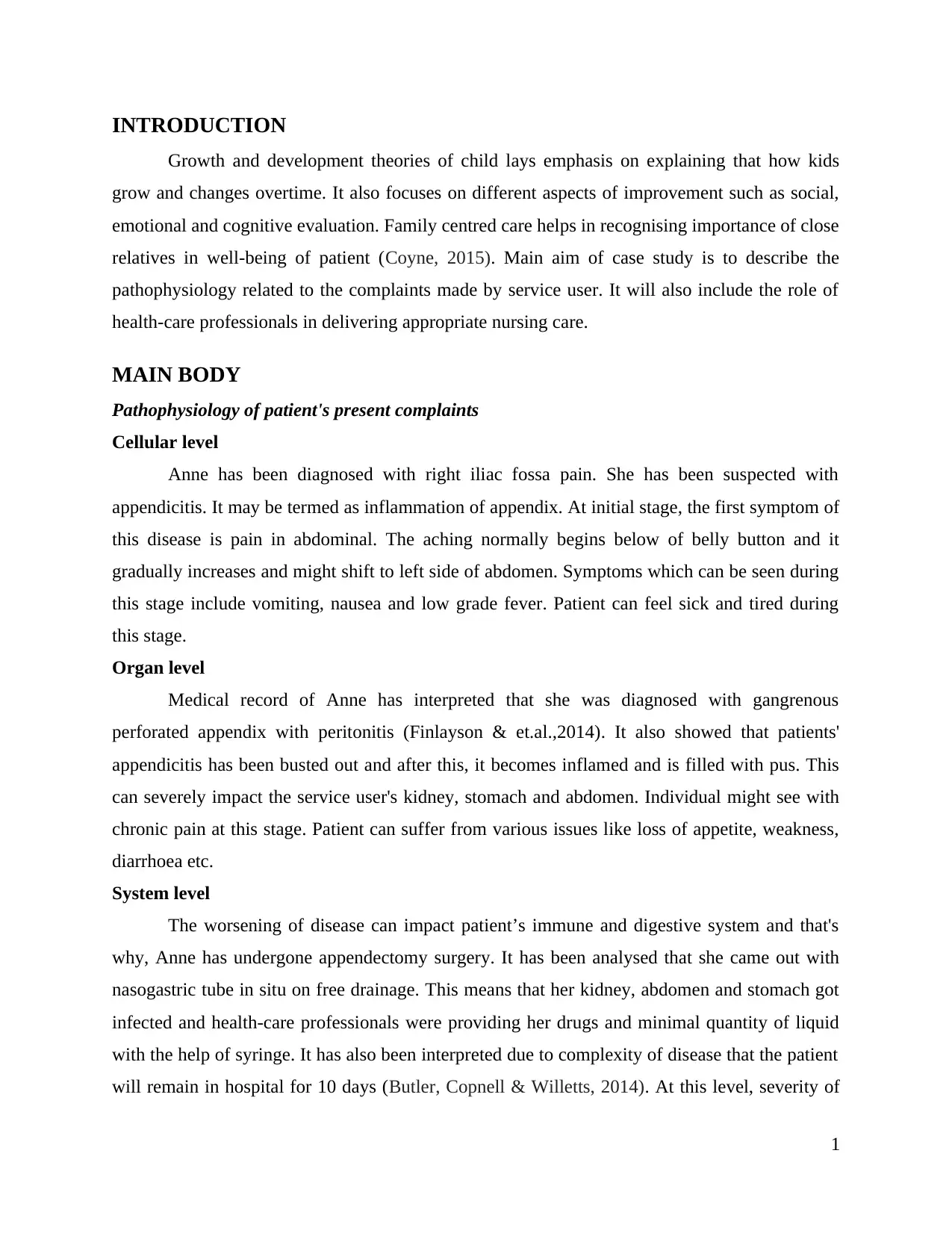
INTRODUCTION
Growth and development theories of child lays emphasis on explaining that how kids
grow and changes overtime. It also focuses on different aspects of improvement such as social,
emotional and cognitive evaluation. Family centred care helps in recognising importance of close
relatives in well-being of patient (Coyne, 2015). Main aim of case study is to describe the
pathophysiology related to the complaints made by service user. It will also include the role of
health-care professionals in delivering appropriate nursing care.
MAIN BODY
Pathophysiology of patient's present complaints
Cellular level
Anne has been diagnosed with right iliac fossa pain. She has been suspected with
appendicitis. It may be termed as inflammation of appendix. At initial stage, the first symptom of
this disease is pain in abdominal. The aching normally begins below of belly button and it
gradually increases and might shift to left side of abdomen. Symptoms which can be seen during
this stage include vomiting, nausea and low grade fever. Patient can feel sick and tired during
this stage.
Organ level
Medical record of Anne has interpreted that she was diagnosed with gangrenous
perforated appendix with peritonitis (Finlayson & et.al.,2014). It also showed that patients'
appendicitis has been busted out and after this, it becomes inflamed and is filled with pus. This
can severely impact the service user's kidney, stomach and abdomen. Individual might see with
chronic pain at this stage. Patient can suffer from various issues like loss of appetite, weakness,
diarrhoea etc.
System level
The worsening of disease can impact patient’s immune and digestive system and that's
why, Anne has undergone appendectomy surgery. It has been analysed that she came out with
nasogastric tube in situ on free drainage. This means that her kidney, abdomen and stomach got
infected and health-care professionals were providing her drugs and minimal quantity of liquid
with the help of syringe. It has also been interpreted due to complexity of disease that the patient
will remain in hospital for 10 days (Butler, Copnell & Willetts, 2014). At this level, severity of
1
Growth and development theories of child lays emphasis on explaining that how kids
grow and changes overtime. It also focuses on different aspects of improvement such as social,
emotional and cognitive evaluation. Family centred care helps in recognising importance of close
relatives in well-being of patient (Coyne, 2015). Main aim of case study is to describe the
pathophysiology related to the complaints made by service user. It will also include the role of
health-care professionals in delivering appropriate nursing care.
MAIN BODY
Pathophysiology of patient's present complaints
Cellular level
Anne has been diagnosed with right iliac fossa pain. She has been suspected with
appendicitis. It may be termed as inflammation of appendix. At initial stage, the first symptom of
this disease is pain in abdominal. The aching normally begins below of belly button and it
gradually increases and might shift to left side of abdomen. Symptoms which can be seen during
this stage include vomiting, nausea and low grade fever. Patient can feel sick and tired during
this stage.
Organ level
Medical record of Anne has interpreted that she was diagnosed with gangrenous
perforated appendix with peritonitis (Finlayson & et.al.,2014). It also showed that patients'
appendicitis has been busted out and after this, it becomes inflamed and is filled with pus. This
can severely impact the service user's kidney, stomach and abdomen. Individual might see with
chronic pain at this stage. Patient can suffer from various issues like loss of appetite, weakness,
diarrhoea etc.
System level
The worsening of disease can impact patient’s immune and digestive system and that's
why, Anne has undergone appendectomy surgery. It has been analysed that she came out with
nasogastric tube in situ on free drainage. This means that her kidney, abdomen and stomach got
infected and health-care professionals were providing her drugs and minimal quantity of liquid
with the help of syringe. It has also been interpreted due to complexity of disease that the patient
will remain in hospital for 10 days (Butler, Copnell & Willetts, 2014). At this level, severity of
1
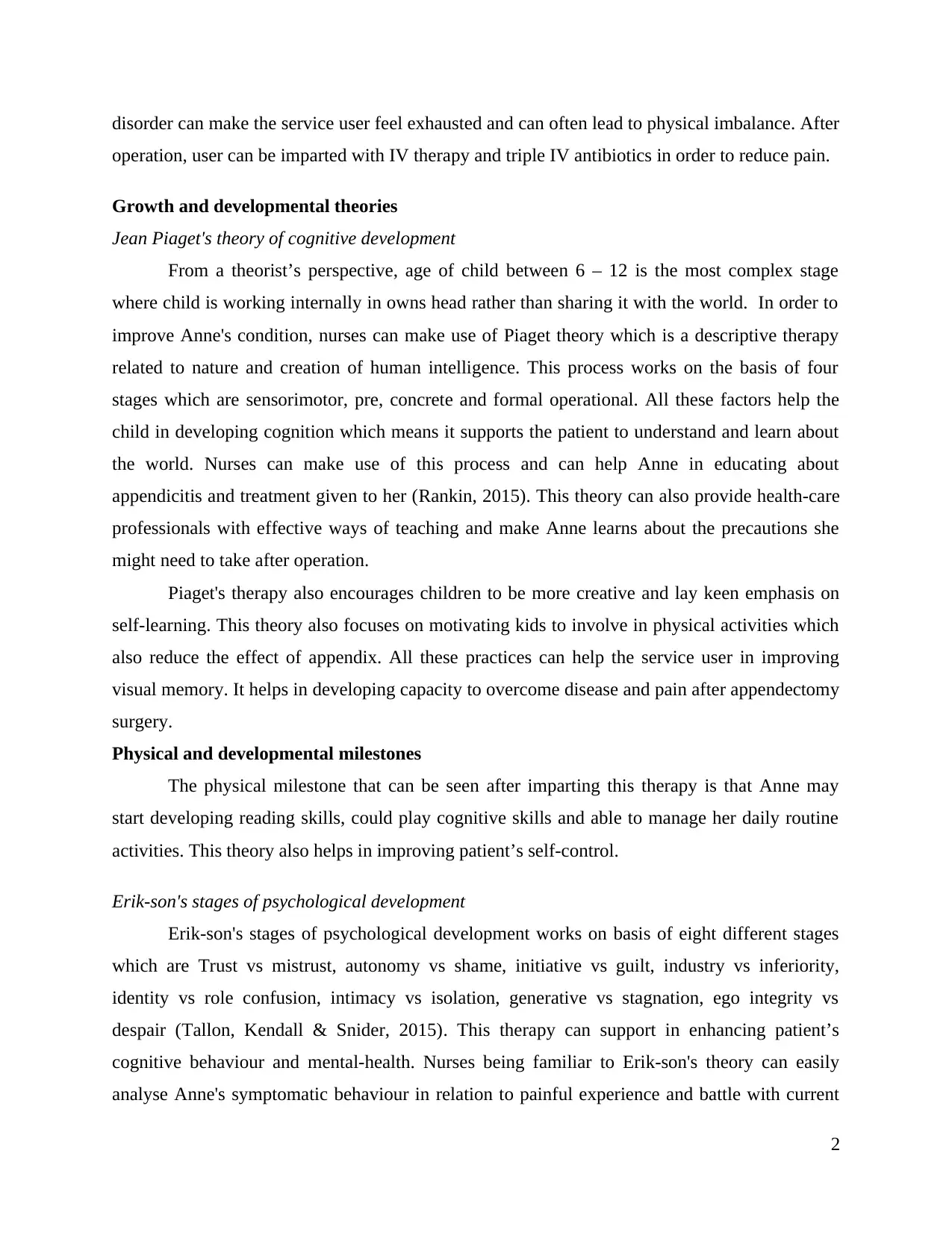
disorder can make the service user feel exhausted and can often lead to physical imbalance. After
operation, user can be imparted with IV therapy and triple IV antibiotics in order to reduce pain.
Growth and developmental theories
Jean Piaget's theory of cognitive development
From a theorist’s perspective, age of child between 6 – 12 is the most complex stage
where child is working internally in owns head rather than sharing it with the world. In order to
improve Anne's condition, nurses can make use of Piaget theory which is a descriptive therapy
related to nature and creation of human intelligence. This process works on the basis of four
stages which are sensorimotor, pre, concrete and formal operational. All these factors help the
child in developing cognition which means it supports the patient to understand and learn about
the world. Nurses can make use of this process and can help Anne in educating about
appendicitis and treatment given to her (Rankin, 2015). This theory can also provide health-care
professionals with effective ways of teaching and make Anne learns about the precautions she
might need to take after operation.
Piaget's therapy also encourages children to be more creative and lay keen emphasis on
self-learning. This theory also focuses on motivating kids to involve in physical activities which
also reduce the effect of appendix. All these practices can help the service user in improving
visual memory. It helps in developing capacity to overcome disease and pain after appendectomy
surgery.
Physical and developmental milestones
The physical milestone that can be seen after imparting this therapy is that Anne may
start developing reading skills, could play cognitive skills and able to manage her daily routine
activities. This theory also helps in improving patient’s self-control.
Erik-son's stages of psychological development
Erik-son's stages of psychological development works on basis of eight different stages
which are Trust vs mistrust, autonomy vs shame, initiative vs guilt, industry vs inferiority,
identity vs role confusion, intimacy vs isolation, generative vs stagnation, ego integrity vs
despair (Tallon, Kendall & Snider, 2015). This therapy can support in enhancing patient’s
cognitive behaviour and mental-health. Nurses being familiar to Erik-son's theory can easily
analyse Anne's symptomatic behaviour in relation to painful experience and battle with current
2
operation, user can be imparted with IV therapy and triple IV antibiotics in order to reduce pain.
Growth and developmental theories
Jean Piaget's theory of cognitive development
From a theorist’s perspective, age of child between 6 – 12 is the most complex stage
where child is working internally in owns head rather than sharing it with the world. In order to
improve Anne's condition, nurses can make use of Piaget theory which is a descriptive therapy
related to nature and creation of human intelligence. This process works on the basis of four
stages which are sensorimotor, pre, concrete and formal operational. All these factors help the
child in developing cognition which means it supports the patient to understand and learn about
the world. Nurses can make use of this process and can help Anne in educating about
appendicitis and treatment given to her (Rankin, 2015). This theory can also provide health-care
professionals with effective ways of teaching and make Anne learns about the precautions she
might need to take after operation.
Piaget's therapy also encourages children to be more creative and lay keen emphasis on
self-learning. This theory also focuses on motivating kids to involve in physical activities which
also reduce the effect of appendix. All these practices can help the service user in improving
visual memory. It helps in developing capacity to overcome disease and pain after appendectomy
surgery.
Physical and developmental milestones
The physical milestone that can be seen after imparting this therapy is that Anne may
start developing reading skills, could play cognitive skills and able to manage her daily routine
activities. This theory also helps in improving patient’s self-control.
Erik-son's stages of psychological development
Erik-son's stages of psychological development works on basis of eight different stages
which are Trust vs mistrust, autonomy vs shame, initiative vs guilt, industry vs inferiority,
identity vs role confusion, intimacy vs isolation, generative vs stagnation, ego integrity vs
despair (Tallon, Kendall & Snider, 2015). This therapy can support in enhancing patient’s
cognitive behaviour and mental-health. Nurses being familiar to Erik-son's theory can easily
analyse Anne's symptomatic behaviour in relation to painful experience and battle with current
2
Secure Best Marks with AI Grader
Need help grading? Try our AI Grader for instant feedback on your assignments.
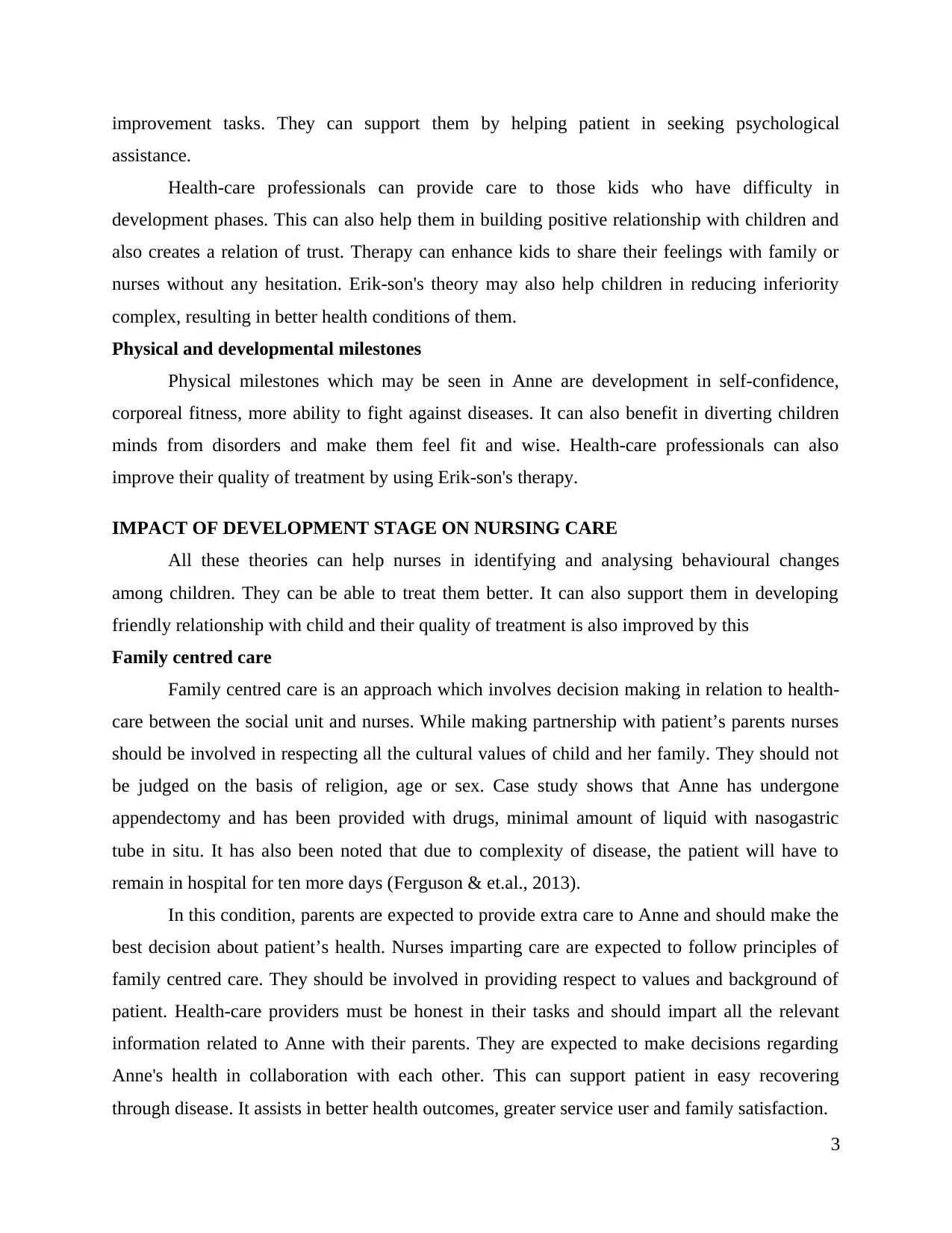
improvement tasks. They can support them by helping patient in seeking psychological
assistance.
Health-care professionals can provide care to those kids who have difficulty in
development phases. This can also help them in building positive relationship with children and
also creates a relation of trust. Therapy can enhance kids to share their feelings with family or
nurses without any hesitation. Erik-son's theory may also help children in reducing inferiority
complex, resulting in better health conditions of them.
Physical and developmental milestones
Physical milestones which may be seen in Anne are development in self-confidence,
corporeal fitness, more ability to fight against diseases. It can also benefit in diverting children
minds from disorders and make them feel fit and wise. Health-care professionals can also
improve their quality of treatment by using Erik-son's therapy.
IMPACT OF DEVELOPMENT STAGE ON NURSING CARE
All these theories can help nurses in identifying and analysing behavioural changes
among children. They can be able to treat them better. It can also support them in developing
friendly relationship with child and their quality of treatment is also improved by this
Family centred care
Family centred care is an approach which involves decision making in relation to health-
care between the social unit and nurses. While making partnership with patient’s parents nurses
should be involved in respecting all the cultural values of child and her family. They should not
be judged on the basis of religion, age or sex. Case study shows that Anne has undergone
appendectomy and has been provided with drugs, minimal amount of liquid with nasogastric
tube in situ. It has also been noted that due to complexity of disease, the patient will have to
remain in hospital for ten more days (Ferguson & et.al., 2013).
In this condition, parents are expected to provide extra care to Anne and should make the
best decision about patient’s health. Nurses imparting care are expected to follow principles of
family centred care. They should be involved in providing respect to values and background of
patient. Health-care providers must be honest in their tasks and should impart all the relevant
information related to Anne with their parents. They are expected to make decisions regarding
Anne's health in collaboration with each other. This can support patient in easy recovering
through disease. It assists in better health outcomes, greater service user and family satisfaction.
3
assistance.
Health-care professionals can provide care to those kids who have difficulty in
development phases. This can also help them in building positive relationship with children and
also creates a relation of trust. Therapy can enhance kids to share their feelings with family or
nurses without any hesitation. Erik-son's theory may also help children in reducing inferiority
complex, resulting in better health conditions of them.
Physical and developmental milestones
Physical milestones which may be seen in Anne are development in self-confidence,
corporeal fitness, more ability to fight against diseases. It can also benefit in diverting children
minds from disorders and make them feel fit and wise. Health-care professionals can also
improve their quality of treatment by using Erik-son's therapy.
IMPACT OF DEVELOPMENT STAGE ON NURSING CARE
All these theories can help nurses in identifying and analysing behavioural changes
among children. They can be able to treat them better. It can also support them in developing
friendly relationship with child and their quality of treatment is also improved by this
Family centred care
Family centred care is an approach which involves decision making in relation to health-
care between the social unit and nurses. While making partnership with patient’s parents nurses
should be involved in respecting all the cultural values of child and her family. They should not
be judged on the basis of religion, age or sex. Case study shows that Anne has undergone
appendectomy and has been provided with drugs, minimal amount of liquid with nasogastric
tube in situ. It has also been noted that due to complexity of disease, the patient will have to
remain in hospital for ten more days (Ferguson & et.al., 2013).
In this condition, parents are expected to provide extra care to Anne and should make the
best decision about patient’s health. Nurses imparting care are expected to follow principles of
family centred care. They should be involved in providing respect to values and background of
patient. Health-care providers must be honest in their tasks and should impart all the relevant
information related to Anne with their parents. They are expected to make decisions regarding
Anne's health in collaboration with each other. This can support patient in easy recovering
through disease. It assists in better health outcomes, greater service user and family satisfaction.
3
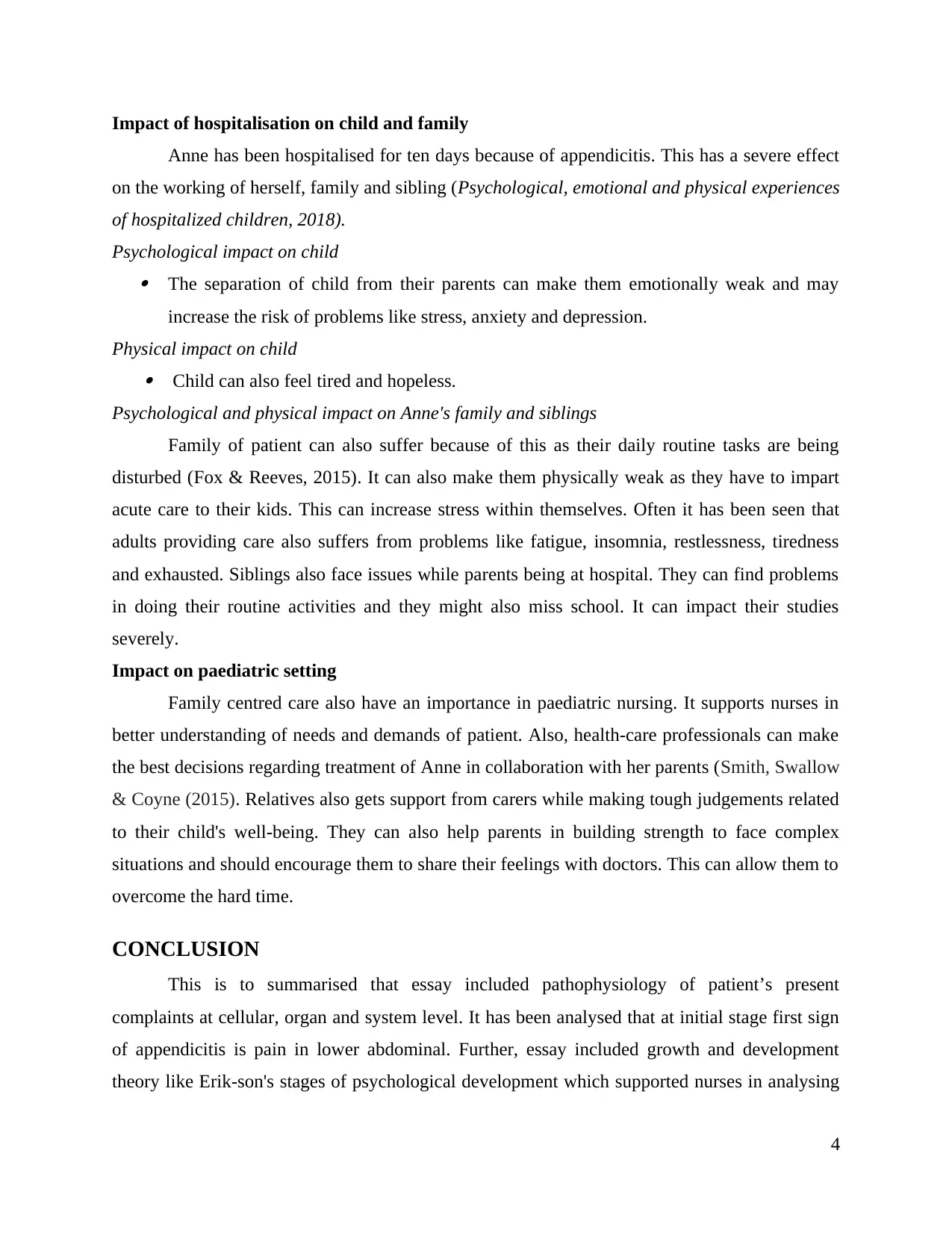
Impact of hospitalisation on child and family
Anne has been hospitalised for ten days because of appendicitis. This has a severe effect
on the working of herself, family and sibling (Psychological, emotional and physical experiences
of hospitalized children, 2018).
Psychological impact on child The separation of child from their parents can make them emotionally weak and may
increase the risk of problems like stress, anxiety and depression.
Physical impact on child Child can also feel tired and hopeless.
Psychological and physical impact on Anne's family and siblings
Family of patient can also suffer because of this as their daily routine tasks are being
disturbed (Fox & Reeves, 2015). It can also make them physically weak as they have to impart
acute care to their kids. This can increase stress within themselves. Often it has been seen that
adults providing care also suffers from problems like fatigue, insomnia, restlessness, tiredness
and exhausted. Siblings also face issues while parents being at hospital. They can find problems
in doing their routine activities and they might also miss school. It can impact their studies
severely.
Impact on paediatric setting
Family centred care also have an importance in paediatric nursing. It supports nurses in
better understanding of needs and demands of patient. Also, health-care professionals can make
the best decisions regarding treatment of Anne in collaboration with her parents (Smith, Swallow
& Coyne (2015). Relatives also gets support from carers while making tough judgements related
to their child's well-being. They can also help parents in building strength to face complex
situations and should encourage them to share their feelings with doctors. This can allow them to
overcome the hard time.
CONCLUSION
This is to summarised that essay included pathophysiology of patient’s present
complaints at cellular, organ and system level. It has been analysed that at initial stage first sign
of appendicitis is pain in lower abdominal. Further, essay included growth and development
theory like Erik-son's stages of psychological development which supported nurses in analysing
4
Anne has been hospitalised for ten days because of appendicitis. This has a severe effect
on the working of herself, family and sibling (Psychological, emotional and physical experiences
of hospitalized children, 2018).
Psychological impact on child The separation of child from their parents can make them emotionally weak and may
increase the risk of problems like stress, anxiety and depression.
Physical impact on child Child can also feel tired and hopeless.
Psychological and physical impact on Anne's family and siblings
Family of patient can also suffer because of this as their daily routine tasks are being
disturbed (Fox & Reeves, 2015). It can also make them physically weak as they have to impart
acute care to their kids. This can increase stress within themselves. Often it has been seen that
adults providing care also suffers from problems like fatigue, insomnia, restlessness, tiredness
and exhausted. Siblings also face issues while parents being at hospital. They can find problems
in doing their routine activities and they might also miss school. It can impact their studies
severely.
Impact on paediatric setting
Family centred care also have an importance in paediatric nursing. It supports nurses in
better understanding of needs and demands of patient. Also, health-care professionals can make
the best decisions regarding treatment of Anne in collaboration with her parents (Smith, Swallow
& Coyne (2015). Relatives also gets support from carers while making tough judgements related
to their child's well-being. They can also help parents in building strength to face complex
situations and should encourage them to share their feelings with doctors. This can allow them to
overcome the hard time.
CONCLUSION
This is to summarised that essay included pathophysiology of patient’s present
complaints at cellular, organ and system level. It has been analysed that at initial stage first sign
of appendicitis is pain in lower abdominal. Further, essay included growth and development
theory like Erik-son's stages of psychological development which supported nurses in analysing
4
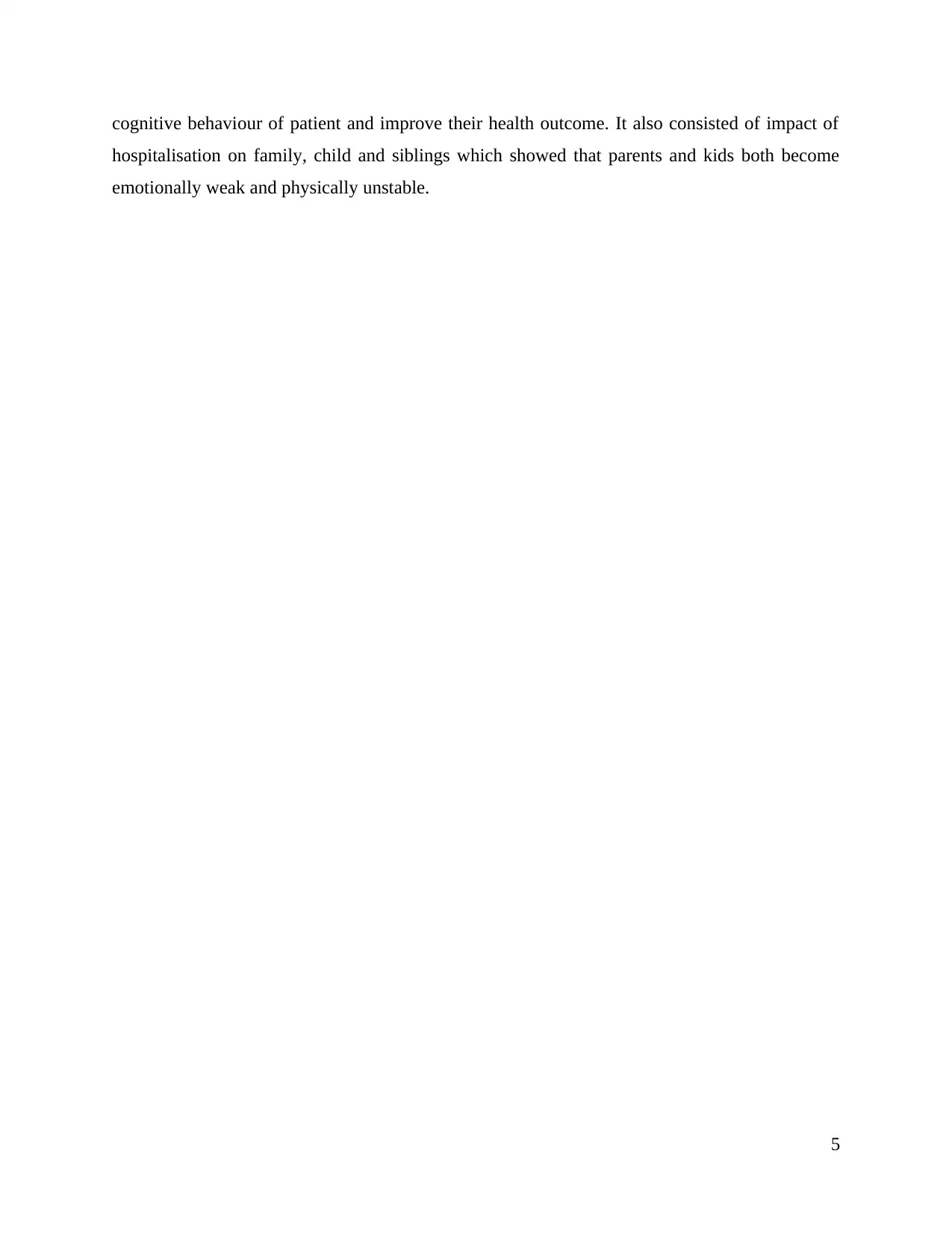
cognitive behaviour of patient and improve their health outcome. It also consisted of impact of
hospitalisation on family, child and siblings which showed that parents and kids both become
emotionally weak and physically unstable.
5
hospitalisation on family, child and siblings which showed that parents and kids both become
emotionally weak and physically unstable.
5
Paraphrase This Document
Need a fresh take? Get an instant paraphrase of this document with our AI Paraphraser
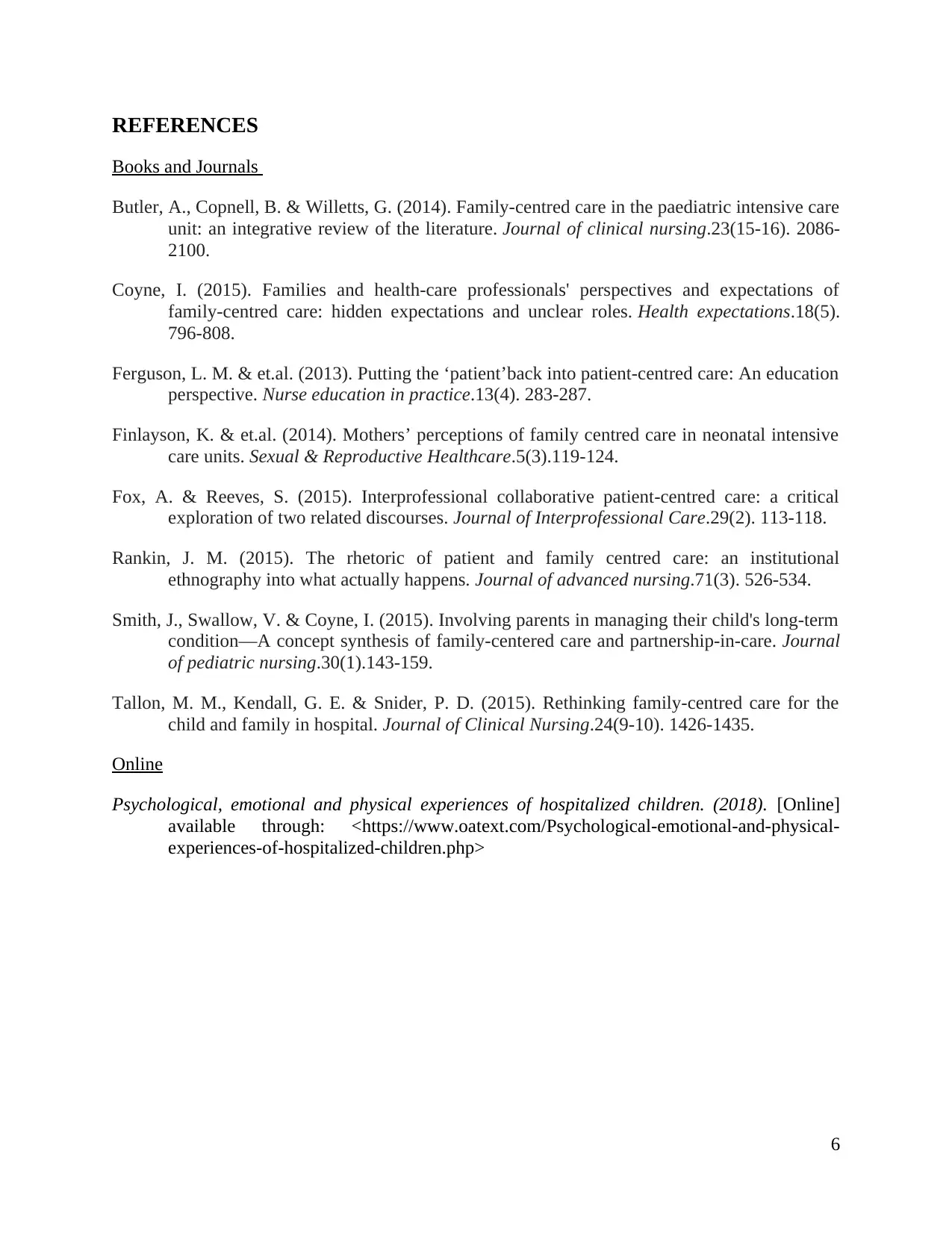
REFERENCES
Books and Journals
Butler, A., Copnell, B. & Willetts, G. (2014). Family‐centred care in the paediatric intensive care
unit: an integrative review of the literature. Journal of clinical nursing.23(15-16). 2086-
2100.
Coyne, I. (2015). Families and health‐care professionals' perspectives and expectations of
family‐centred care: hidden expectations and unclear roles. Health expectations.18(5).
796-808.
Ferguson, L. M. & et.al. (2013). Putting the ‘patient’back into patient-centred care: An education
perspective. Nurse education in practice.13(4). 283-287.
Finlayson, K. & et.al. (2014). Mothers’ perceptions of family centred care in neonatal intensive
care units. Sexual & Reproductive Healthcare.5(3).119-124.
Fox, A. & Reeves, S. (2015). Interprofessional collaborative patient-centred care: a critical
exploration of two related discourses. Journal of Interprofessional Care.29(2). 113-118.
Rankin, J. M. (2015). The rhetoric of patient and family centred care: an institutional
ethnography into what actually happens. Journal of advanced nursing.71(3). 526-534.
Smith, J., Swallow, V. & Coyne, I. (2015). Involving parents in managing their child's long-term
condition—A concept synthesis of family-centered care and partnership-in-care. Journal
of pediatric nursing.30(1).143-159.
Tallon, M. M., Kendall, G. E. & Snider, P. D. (2015). Rethinking family‐centred care for the
child and family in hospital. Journal of Clinical Nursing.24(9-10). 1426-1435.
Online
Psychological, emotional and physical experiences of hospitalized children. (2018). [Online]
available through: <https://www.oatext.com/Psychological-emotional-and-physical-
experiences-of-hospitalized-children.php>
6
Books and Journals
Butler, A., Copnell, B. & Willetts, G. (2014). Family‐centred care in the paediatric intensive care
unit: an integrative review of the literature. Journal of clinical nursing.23(15-16). 2086-
2100.
Coyne, I. (2015). Families and health‐care professionals' perspectives and expectations of
family‐centred care: hidden expectations and unclear roles. Health expectations.18(5).
796-808.
Ferguson, L. M. & et.al. (2013). Putting the ‘patient’back into patient-centred care: An education
perspective. Nurse education in practice.13(4). 283-287.
Finlayson, K. & et.al. (2014). Mothers’ perceptions of family centred care in neonatal intensive
care units. Sexual & Reproductive Healthcare.5(3).119-124.
Fox, A. & Reeves, S. (2015). Interprofessional collaborative patient-centred care: a critical
exploration of two related discourses. Journal of Interprofessional Care.29(2). 113-118.
Rankin, J. M. (2015). The rhetoric of patient and family centred care: an institutional
ethnography into what actually happens. Journal of advanced nursing.71(3). 526-534.
Smith, J., Swallow, V. & Coyne, I. (2015). Involving parents in managing their child's long-term
condition—A concept synthesis of family-centered care and partnership-in-care. Journal
of pediatric nursing.30(1).143-159.
Tallon, M. M., Kendall, G. E. & Snider, P. D. (2015). Rethinking family‐centred care for the
child and family in hospital. Journal of Clinical Nursing.24(9-10). 1426-1435.
Online
Psychological, emotional and physical experiences of hospitalized children. (2018). [Online]
available through: <https://www.oatext.com/Psychological-emotional-and-physical-
experiences-of-hospitalized-children.php>
6
1 out of 8
Related Documents
Your All-in-One AI-Powered Toolkit for Academic Success.
+13062052269
info@desklib.com
Available 24*7 on WhatsApp / Email
![[object Object]](/_next/static/media/star-bottom.7253800d.svg)
Unlock your academic potential
© 2024 | Zucol Services PVT LTD | All rights reserved.





